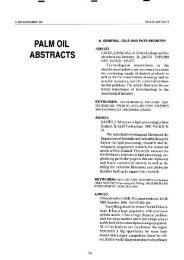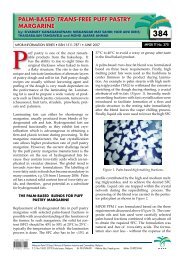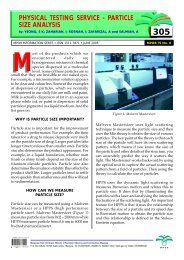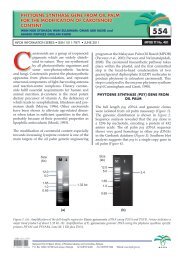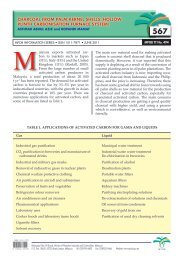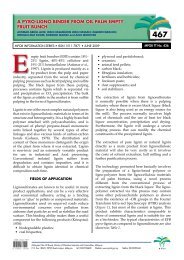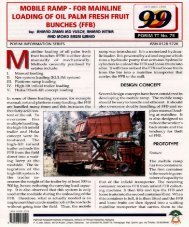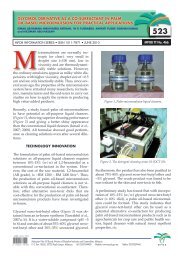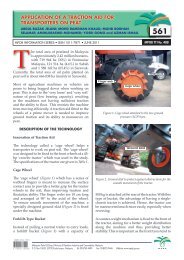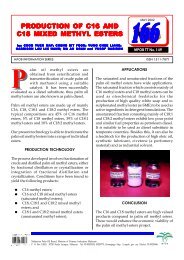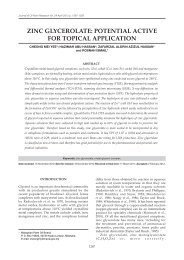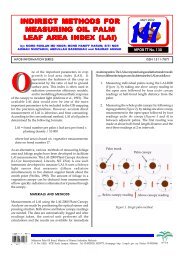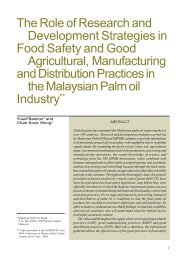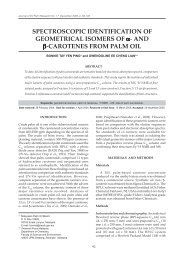production of palm-based tocotrienols-enhanced fraction (tef)
production of palm-based tocotrienols-enhanced fraction (tef)
production of palm-based tocotrienols-enhanced fraction (tef)
Create successful ePaper yourself
Turn your PDF publications into a flip-book with our unique Google optimized e-Paper software.
TABLE 1. TOCOPHEROLS AND TOCOTRIENOLS CONTENT OF<br />
TOCOTRIENOLS PREPARATIONS<br />
Tocotrienols α-Tocopherol α-Tocotrienol γ-Tocotrienol δ-Tocotrienol Total<br />
Preparation (%) (%) (%) (%) (%)<br />
Palm Vitamin E 17.8 17.1 23.0 17.2 75.1<br />
(TRF)<br />
MPOB-T3 Mix88 2.6 25.2 37.9 24.9 90.6<br />
(TEF)<br />
MPOB-T3 Mix50 1.5 14.6 21.6 14.8 52.5<br />
Notes: TRF = <strong>tocotrienols</strong>-rich <strong>fraction</strong>.<br />
TEF = <strong>tocotrienols</strong>-<strong>enhanced</strong> <strong>fraction</strong>.<br />
(Figure 2) with <strong>tocotrienols</strong> content 51% is prepared<br />
by blending MPOB-T3Mix88 with RBD <strong>palm</strong> olein<br />
accordingly. The product (MPOB-T3 Mix50) with a<br />
minimal <strong>tocotrienols</strong> content <strong>of</strong> 50%, can be easily<br />
promoted for various applications.<br />
Figure 2. Palm-<strong>based</strong> <strong>tocotrienols</strong> (MPOB-T3Mix50).<br />
POTENTIAL BENEFITS OF TOCOTRIENOLS<br />
Both tocopherols and <strong>tocotrienols</strong> are known for their<br />
antioxidant activities in foods and biological systems<br />
(Ab Gapor et al., 1989; Minhajuddin et al., 2005).<br />
α-Tocotrienol showed better antioxidant activity than<br />
α-tocopherol in the order <strong>of</strong> 40-60 times against lipid<br />
peroxidation (Serbinova et al., 1991). In a human<br />
study, O’Byrne et al. (2000) reported that α-tocotrienol<br />
may be potent in decreasing low-density lipoprotein<br />
(LDL) oxidizability. Tocotrienols have been shown<br />
to be a potential hypocholesterolemic agent (Qureshi<br />
et al., 1995; Hasselwander et al., 2002). Tocotrienols<br />
have also been shown to have anti-cancer activities<br />
(Kato et al., 1985; Komiyama et al., l989; Wan Ngah et<br />
al., 1999; Nesaretnam et al., 2000). The superiority <strong>of</strong><br />
<strong>tocotrienols</strong> over tocopherols in anti-cancer effects<br />
have been confirmed (Guthrie et al., 1997; Yu et al.,<br />
1999; McIntyre et al., 2000; Yu et al., 2003). Tocotrienols<br />
have been reported to show anti-angiogenic activity,<br />
suggesting potential usefulness as a therapeutic<br />
agent for tumour angiogenesis (Miyazawa et al.,<br />
2004). α-Tocotrienol but not tocopherols has been<br />
shown to be a potent neuroprotection agent (Sen et<br />
al., 2000; Osakada et al., 2004). Anderson et al. (2003)<br />
reported that <strong>tocotrienols</strong> induce IKBKAP<br />
expression, thus suggesting a possible therapy for<br />
familial dysautonomia.<br />
CONCLUSION<br />
A substantial amount <strong>of</strong> evidence indicates that<br />
<strong>tocotrienols</strong> are more effective than tocopherols in health<br />
promoting activities including hypocholesterolemic,<br />
anti-cancer and antioxidant properties. Technology<br />
for producing TEF is available for further<br />
development. The products are expected to have<br />
applications in the high end nutraceuticals,<br />
functional foods and cosmetics industries.<br />
ACKNOWLEDGEMENT<br />
The author would like to thank the management <strong>of</strong><br />
MPOB especially its Director-General for their<br />
encouragement and support. Many thanks are also<br />
due to Meriam Hassan and Mahani Rifaeh for their<br />
excellent technical assistance.



